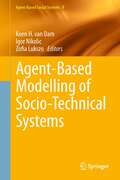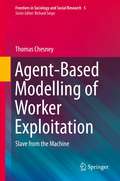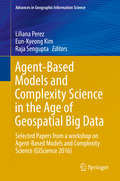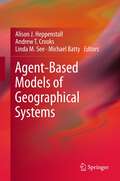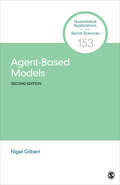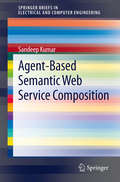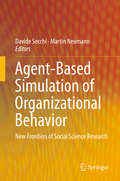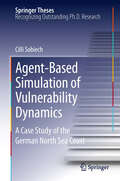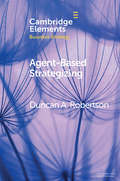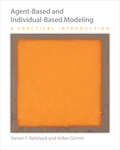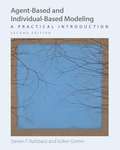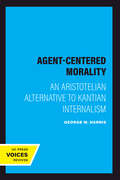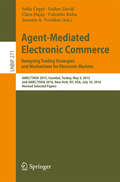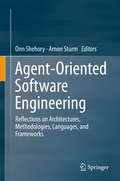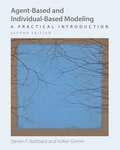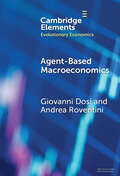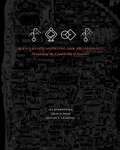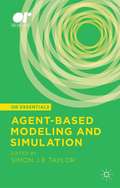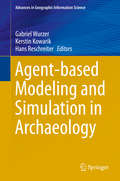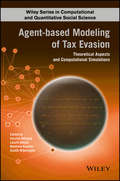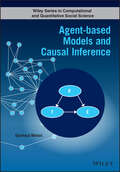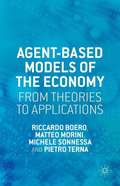- Table View
- List View
Agent-Based Modelling of Socio-Technical Systems (Agent-Based Social Systems #9)
by Zofia Lukszo Koen H. Dam Igor NikolicDecision makers in large scale interconnected network systems require simulation models for decision support. The behaviour of these systems is determined by many actors, situated in a dynamic, multi-actor, multi-objective and multi-level environment. How can such systems be modelled and how can the socio-technical complexity be captured? Agent-based modelling is a proven approach to handle this challenge. This book provides a practical introduction to agent-based modelling of socio-technical systems, based on a methodology that has been developed at TU Delft and which has been deployed in a large number of case studies. The book consists of two parts: the first presents the background, theory and methodology as well as practical guidelines and procedures for building models. In the second part this theory is applied to a number of case studies, where for each model the development steps are presented extensively, preparing the reader for creating own models.
Agent-Based Modelling of Worker Exploitation: Slave from the Machine (Frontiers in Sociology and Social Research #5)
by Thomas ChesneyThis book illustrates the potential for computer simulation in the study of modern slavery and worker abuse, and by extension in all social issues. It lays out a philosophy of how agent-based modelling can be used in the social sciences. In addressing modern slavery, Chesney considers precarious work that is vulnerable to abuse, like sweat-shop labour and prostitution, and shows how agent modelling can be used to study, understand and fight abuse in these areas. He explores the philosophy, application and practice of agent modelling through the popular and free software NetLogo. This topical book is grounded in the technology needed to address the messy, chaotic, real world problems that humanity faces—in this case the serious problem of abuse at work—but equally in the social sciences which are needed to avoid the unintended consequences inherent to human responses. It includes a short but extensive NetLogo guide which readers can use to quickly learn this software and go on to develop complex models. This is an important book for students and researchers of computational social science and others interested in agent-based modelling.
Agent-Based Models and Complexity Science in the Age of Geospatial Big Data: Selected Papers from a workshop on Agent-Based Models and Complexity Science (GIScience 2016) (Advances in Geographic Information Science)
by Liliana Perez Eun-Kyeong Kim Raja SenguptaThis book contains a selection of papers presented during a special workshop on Complexity Science organized as part of the 9th International Conference on GIScience 2016. Expert researchers in the areas of Agent-Based Modeling, Complexity Theory, Network Theory, Big Data, and emerging methods of Analysis and Visualization for new types of data explore novel complexity science approaches to dynamic geographic phenomena and their applications, addressing challenges and enriching research methodologies in geography in a Big Data Era.
Agent-Based Models in Economics: A Toolkit
by Domenico Delli Gatti Mauro Gallegati Alberto Russo Giorgio Fagiolo Matteo RichiardiIn contrast to mainstream economics, complexity theory conceives the economy as a complex system of heterogeneous interacting agents characterised by limited information and bounded rationality. Agent Based Models (ABMs) are the analytical and computational tools developed by the proponents of this emerging methodology. <P><P>Aimed at students and scholars of contemporary economics, this book includes a comprehensive toolkit for agent-based computational economics, now quickly becoming the new way to study evolving economic systems. Leading scholars in the field explain how ABMs can be applied fruitfully to many real-world economic examples and represent a great advancement over mainstream approaches. The essays discuss the methodological bases of agent-based approaches and demonstrate step-by-step how to build, simulate and analyse ABMs and how to validate their outputs empirically using the data. They also present a wide set of applications of these models to key economic topics, including the business cycle, labour markets, and economic growth.<P> Applies the major new theory of agent-based modelling to real-world economic topics.<P> Accessibly written but rigourous.<P> Edited by leading figures in the field.
Agent-Based Models of Geographical Systems
by Michael Batty Alison J. Heppenstall Andrew T. Crooks Linda M. SeeThis unique book brings together a comprehensive set of papers on the background, theory, technical issues and applications of agent-based modelling (ABM) within geographical systems. This collection of papers is an invaluable reference point for the experienced agent-based modeller as well those new to the area. Specific geographical issues such as handling scale and space are dealt with as well as practical advice from leading experts about designing and creating ABMs, handling complexity, visualising and validating model outputs. With contributions from many of the world's leading research institutions, the latest applied research (micro and macro applications) from around the globe exemplify what can be achieved in geographical context. This book is relevant to researchers, postgraduate and advanced undergraduate students, and professionals in the areas of quantitative geography, spatial analysis, spatial modelling, social simulation modelling and geographical information sciences.
Agent-Based Models: Agent-based Modelling Using The Skin Platform (Quantitative Applications in the Social Sciences #153)
by Nigel GilbertAgent-based simulation has become increasingly popular as a modeling approach in the social sciences because it enables researchers to build models where individual entities and their interactions are directly represented. The Second Edition of Nigel Gilbert′s Agent-Based Models introduces this technique; considers a range of methodological and theoretical issues; shows how to design an agent-based model, with a simple example; offers some practical advice about developing, verifying and validating agent-based models; and finally discusses how to plan an agent-based modelling project, publish the results and apply agent-based modeling to formulate and evaluate social and economic policies.
Agent-Based Models: Agent-based Modelling Using The Skin Platform (Quantitative Applications in the Social Sciences #153)
by Nigel GilbertAgent-based simulation has become increasingly popular as a modeling approach in the social sciences because it enables researchers to build models where individual entities and their interactions are directly represented. The Second Edition of Nigel Gilbert′s Agent-Based Models introduces this technique; considers a range of methodological and theoretical issues; shows how to design an agent-based model, with a simple example; offers some practical advice about developing, verifying and validating agent-based models; and finally discusses how to plan an agent-based modelling project, publish the results and apply agent-based modeling to formulate and evaluate social and economic policies.
Agent-Based Semantic Web Service Composition (SpringerBriefs in Electrical and Computer Engineering)
by Sandeep KumarAgent-based Semantic Web Service Composition closely examines the various aspects of SWS composition, and explores the concept that a Multi-Agent system can serve as an SWS composition system in which its agents can interact with one another to satisfy a high-level goal. In addition to surveying various proposed multi-agent-based SWS composition models, the book also highlights the cognitive parameter-based semantic web service selection models that can be used in multi-agent-based SWS composition, and outlines a new negotiation agreement-based SWS composition that can outperform existing techniques. Agent-based Semantic Web Service Composition is intended for researchers and practitioners as a reference guide for optimizing SWS composition and implementing multi-agent systems. Instructors and other academics working in a related field will also find the book invaluable.
Agent-Based Simulation of Organizational Behavior: New Frontiers of Social Science Research
by Davide Secchi Martin NeumannThe aim of this book is to demonstrate how Agent-Based Modelling (ABM) can be used to enhance the study of social agency, organizational behavior and organizational management. It derives from a workshop, sponsored by the Society for the Study of Artificial Intelligence and the Simulation of Behavior (AISB), held at Bournemouth University Business School in 2014 on "Modelling Organizational Behavior and Social Agency". The contents of this book are divided into four themes: Perspectives, Modeling Organizational Behavior, Philosophical and Methodological Perspective, and Modeling Organized Crime and Macro-Organizational Phenomena. ABM is a particular and advanced type of computer simulation where the focus of modeling shifts to the agent rather than to the system. This allows for complex and more realistic representations of reality, facilitating an innovative socio-cognitive perspective on organizational studies. The editors and contributing authors claim that the use of ABM may dramatically expand our understanding of human behavior in organizations. This is made possible because of (a) the computational power made available by technological advancements, (b) the relative ease of the programming, (c) the ability to borrow simulation practices from other disciplines, and (d) the ability to demonstrate how the ABM approach clearly enables a socio-cognitive perspective on organizational complexity. Showcasing contributions from academics and researchers of various backgrounds and discipline, this volumes provides a global, interdisciplinary perspective.
Agent-Based Simulation of Vulnerability Dynamics: A Case Study of the German North Sea Coast (Springer Theses)
by Cilli SobiechThis thesis constitutes an extraordinary innovative research approach in transferring the concepts and methods of complex systems to risk research. It ambitiously bridges the barriers between theoretical, empirical and methodical research work and integrates these fields into one comprehensive approach of dealing with uncertainty in socio-ecological systems. The developed agent-based simulation aims at the dynamics of social vulnerability in the considered system of the German North Sea Coast. Thus, the social simulation provides an analytical method to explore the individual, relational, and spatial aspects leading to dynamics of vulnerability in society. Combining complexity science and risk research by the method of agent-based simulation hereby emphasizes the importance of understanding interrelations inside the system for the system's development, i.e. for the evolving. Based on a vulnerability assessment regarding vulnerability characteristics, present risk behavior and self-protection preferences of private households against the impacts of flooding and storm surges, possible system trajectories could be explored by means of simulation experiments. The system-analytical approach therefore contributes to an integrated consideration of multi-dimensional and context-sensitv social phenomena such as vulnerability. Furthermore it achieves conceptually and strategically relevant implications for risk research and complex systems research.
Agent-Based Strategizing (Elements in Business Strategy)
by Duncan A. RobertsonStrategic management is a system of continual disequilibrium, with firms in a continual struggle for competitive advantage and relative fitness. Models that are dynamic in nature are required if we are to really understand the complex notion of sustainable competitive advantage. New tools are required to tackle challenges of how firms should compete in environments characterized by both exogeneous shocks and intense endogenous competition. Agent-based modelling of firms' strategies offers an alternative analytical approach, where individual firm or component parts of a firm are modelled, each with their own strategy. Where traditional models can assume homogeneity of actors, agent-based models simulate each firm individually. This allows experimentation of strategic moves, which is particularly important where reactions to strategic moves are non-trivial. This Element introduces agent-based models and their use within management, reviews the influential NK suite of models, and offers an agenda for the development of agent-based models in strategic management.
Agent-Based and Individual-Based Modeling
by Volker Grimm Steven F. RailsbackAgent-based modeling is a new technique for understanding how the dynamics of biological, social, and other complex systems arise from the characteristics and behaviors of the agents making up these systems. This innovative textbook gives students and scientists the skills to design, implement, and analyze agent-based models. It starts with the fundamentals of modeling and provides an introduction to NetLogo, an easy-to-use, free, and powerful software platform. Nine chapters then each introduce an important modeling concept and show how to implement it using NetLogo. The book goes on to present strategies for finding the right level of model complexity and developing theory for agent behavior, and for analyzing and learning from models. Agent-Based and Individual-Based Modeling features concise and accessible text, numerous examples, and exercises using small but scientific models. The emphasis throughout is on analysis--such as software testing, theory development, robustness analysis, and understanding full models--and on design issues like optimizing model structure and finding good parameter values.The first hands-on introduction to agent-based modeling, from conceptual design to computer implementation to parameterization and analysis Filled with examples and exercises, with updates and supplementary materials at http://www.railsback-grimm-abm-book.com Designed for students and researchers across the biological and social sciences Written by leading practitionersLeading universities that have adopted this book include: Amherst CollegeBrigham Young UniversityCarnegie Mellon UniversityMiami UniversityNorthwestern UniversityOld Dominion UniversityPortland State UniversityRhodes CollegeSusquehanna UniversityUniversity College, DublinUniversity of ArizonaUniversity of South FloridaUniversity of Virginia
Agent-Based and Individual-Based Modeling: A Practical Introduction, Second Edition
by Volker Grimm Steven F. RailsbackThe essential textbook on agent-based modeling—now fully updated and expandedAgent-Based and Individual-Based Modeling has become the standard textbook on the subject for classroom use and self-instruction. Drawing on the latest version of NetLogo and fully updated with new examples, exercises, and an enhanced text for easier comprehension, this is the essential resource for anyone seeking to understand how the dynamics of biological, social, and other complex systems arise from the characteristics of the agents that make up these systems.Steven Railsback and Volker Grimm lead students stepwise through the processes of designing, programming, documenting, and doing scientific research with agent-based models, focusing on the adaptive behaviors that make these models necessary. They cover the fundamentals of modeling and model analysis, introduce key modeling concepts, and demonstrate how to implement them using NetLogo. They also address pattern-oriented modeling, an invaluable strategy for modeling real-world problems and developing theory.This accessible and authoritative book focuses on modeling as a tool for understanding real complex systems. It explains how to pose a specific question, use observations from actual systems to design models, write and test software, and more.A hands-on introduction that guides students from conceptual design to computer implementation to analysisFilled with new examples and exercises and compatible with the latest version of NetLogoIdeal for students and researchers across the natural and social sciencesWritten by two leading practitionersSupported by extensive instructional materials at www.railsback-grimm-abm-book.com
Agent-Centered Morality: An Aristotelian Alternative to Kantian Internalism
by George W. HarrisWhat kinds of persons do we aspire to be, and how do our aspirations fit with our ideas of rationality? In Agent-Centered Morality, George Harris argues that most of us aspire to a certain sort of integrity: We wish to be respectful of and sympathetic to others, and to be loving parents, friends, and members of our communities. Against a prevailing Kantian consensus, Harris offers an Aristotelian view of the problems presented by practical reason, problems of integrating all our concerns into a coherent, meaningful life in a way that preserves our integrity. The task of solving these problems is "the integration test." Systematically addressing the work of major Kantian thinkers, Harris shows that even the most advanced contemporary versions of the Kantian view fail to integrate all of the values that correspond to what we call a moral life. By demonstrating how the meaning of life and practical reason are internally related, he constructs from Aristotle's thought a conceptual scheme that successfully integrates all the characteristics that make a life meaningful, without jeopardizing the place of any. Harris's elucidation of this approach is a major contribution to debates on human agency, practical reason, and morality.
Agent-Mediated Electronic Commerce. Designing Trading Strategies and Mechanisms for Electronic Markets: AMEC 2013, Saint Paul, MN, USA, May 6, 2013, TADA 2013, Bellevue, WA, USA, July 15, 2013, and AMEC and TADA 2014, Paris, France, May 5, 2014, Revised Selected Papers (Lecture Notes in Business Information Processing #187)
by Esther David Onn Shehory Sofia Ceppi Verdan Podobnik Valentin Robu Sebastian Stein Ioannis A. VetsikasThis volume contains 12 thoroughly refereed and revised papers detailing recent advances in research on designing trading agents and mechanisms for agent-mediated e-commerce. They were originally presented at three events: the Workshop on Agent-Mediated Electronic Commerce (AMEC 2013), co-located with AAMAS 2013 in Saint Paul, MN, USA, in May 2013; the Workshop on Trading Agent Design and Analysis (TADA 2013), co-located with AAAI 2013 in Bellevue, WA, USA, in July 2013; and the Joint Workshop on Trading Agent Design and Analysis (TADA 2014) and Agent-Mediated Electronic Commerce (AMEC 2014), co-located with AAMAS 2014 in Paris, France, in May 2014. Given the breadth of research topics in this field, the range of topics addressed in these papers is correspondingly broad. These include the study of theoretical issues related to the design of interaction protocols and marketplaces; the design and analysis of automated trading strategies used by individual agents; and the deployment of such strategies, in times as part of an entry to the trading agent competition.
Agent-Mediated Electronic Commerce. Designing Trading Strategies and Mechanisms for Electronic Markets: AMEC/TADA 2015, Istanbul, Turkey, May 4, 2015, and AMEC/TADA 2016, New York, NY, USA, July 10, 2016, Revised Selected Papers (Lecture Notes in Business Information Processing #271)
by Esther David Sofia Ceppi Valentin Robu Ioannis A. Vetsikas Chen HajajThis volume contains 11 thoroughly refereed and revised papers detailing recent advances in research on designing trading agents and mechanisms for agent-mediated e-commerce. They were originally presented at the Joint Workshop on Trading Agent Design and Analysis (TADA 2012) and Agent-Mediated Electronic Commerce (AMEC 2012) co-located with AAMAS 2012 in Valencia, Spain, in June 2012. The increasing reliance on software agents has created a range of pressing new research challenges, including the design of appropriate agent decision algorithms, approaches for predicting the complex behaviors and interactions of multiple agents, including the computation of equilibria, and the engineering of protocols and mechanisms that ensure electronic markets behave in a stable manner or fulfill other desirable criteria. Drawing upon a diverse range of scientific disciplines, including computer science, economics, artificial intelligence, operations research and game theory, the papers collected in this volume represent a cross-section of recent research and cover topics such as strategies for individual trading agents, the design of markets and interaction protocols between agents, and a variety of applications.
Agent-Oriented Software Engineering: Reflections on Architectures, Methodologies, Languages, and Frameworks
by Onn Shehory Arnon SturmWith this book, Onn Shehory and Arnon Sturm, together with further contributors, introduce the reader to various facets of agent-oriented software engineering (AOSE). They provide a selected collection of state-of-the-art findings, which combines research from information systems, artificial intelligence, distributed systems and software engineering and covers essential development aspects of agent-based systems. The book chapters are organized into five parts. The first part introduces the AOSE domain in general, including introduction to agents and the peculiarities of software engineering for developing MAS. The second part describes general aspects of AOSE, like architectural models, design patterns and communication. Next, part three discusses AOSE methodologies and associated research directions and elaborates on Prometheus, O-MaSE and INGENIAS. Part four then addresses agent-oriented programming languages. Finally, the fifth part presents studies related to the implementation of agents and multi-agent systems. The book not only provides a comprehensive review of design approaches for specifying agent-based systems, but also covers implementation aspects such as communication, standards and tools and environments for developing agent-based systems. It is thus of interest to researchers, practitioners and students who are interested in exploring the agent paradigm for developing software systems.
Agent-based And Individual-based Modeling: A Practical Introduction, Second Edition
by Volker Grimm Steven F. RailsbackAgent-Based and Individual-Based Modeling has become the standard textbook on the subject for classroom use and self-instruction. Drawing on the latest version of NetLogo and fully updated with new examples, exercises, and an enhanced text for easier comprehension, this is the essential resource for anyone seeking to understand how the dynamics of biological, social, and other complex systems arise from the characteristics of the agents that make up these systems. Steven Railsback and Volker Grimm lead students stepwise through the processes of designing, programming, documenting, and doing scientific research with agent-based models, focusing on the adaptive behaviors that make these models necessary. They cover the fundamentals of modeling and model analysis, introduce key modeling concepts, and demonstrate how to implement them using NetLogo. They also address pattern-oriented modeling, an invaluable strategy for modeling real-world problems and developing theory. This accessible and authoritative book focuses on modeling as a tool for understanding real complex systems. It explains how to pose a specific question, use observations from actual systems to design models, write and test software, and more. A hands-on introduction that guides students from conceptual design to computer implementation to analysis Filled with new examples and exercises and compatible with the latest version of NetLogo Ideal for students and researchers across the natural and social sciences Written by two leading practitioners Supported by extensive instructional materials at www.railsback-grimm-abm-book.com
Agent-based Macroeconomics: The Schumpeter Meeting Keynes Models (Elements in Evolutionary Economics)
by Giovanni Dosi Andrea RoventiniThis Element is about agent-based macroeconomics in general, and in particular about a family of evolutionary, agent-based models (ABMs), which are called 'Schumpeter meeting Keynes' (or K+S). The K+S models knit together 'Schumpeterian' endogenous processes of innovation with 'Keynesian' mechanisms of demand generation. As with all well-constructed ABMs, the K+S models are populated by a multiplicity of agents which interact on the grounds of quite simple, empirically based, behavioural rules, whose collective outcomes are 'emergent properties' which cannot be imputed to the intention of any single agent. After the K+S model is empirically validated, the impacts of different combinations of innovation, industrial, fiscal, and monetary policies for different labour-market regimes and inequality scenarios are assessed. The Element offers a new perspective on macroeconomics considering the economy as a complex evolving system.
Agent-based Modeling For Archaeology: Simulating The Complexity Of Societies
by Colin Wren Stefani Crabtree Iza RomanowskaTo fully understand not only the past, but also the trajectories, of human societies, we need a more dynamic view of human social systems. Agent-based modeling (ABM), which can create fine-scale models of behavior over time and space, may reveal important, general patterns of human activity. Agent-Based Modeling for Archaeology is the first ABM textbook designed for researchers studying the human past. Appropriate for scholars from archaeology, the digital humanities, and other social sciences, this book offers novices and more experienced ABM researchers a modular approach to learning ABM and using it effectively. Readers will find the necessary background, discussion of modeling techniques and traps, references, and algorithms to use ABM in their own work. They will also find engaging examples of how other scholars have applied ABM, ranging from the study of the intercontinental migration pathways of early hominins, to the weather–crop–population cycles of the American Southwest, to the trade networks of Ancient Rome. This textbook provides the foundations needed to simulate the complexity of past human societies, offering researchers a richer understanding of the past—and likely future—of our species. The electronic version of this textbook can be downloaded for free at: https://santafeinstitute.github.io/ABMA/
Agent-based Modeling and Simulation
by Simon Je Taylor<P>Operational Research (OR) deals with the use of advanced analytical methods to support better decision-making. It is multidisciplinary with strong links to management science, decision science, computer science and many application areas such as engineering, manufacturing, commerce and healthcare. <P>In the study of emergent behaviour in complex adaptive systems, Agent-based Modelling & Simulation (ABMS) is being used in many different domains such as healthcare, energy, evacuation, commerce, manufacturing and defense. <P>This collection of articles presents a convenient introduction to ABMS with papers ranging from contemporary views to representative case studies. The OR Essentials series presents a unique cross-section of high quality research work fundamental to understanding contemporary issues and research across a range of Operational Research (OR) topics. It brings together some of the best research papers from the esteemed Operational Research Society and its associated journals, also published by Palgrave Macmillan.
Agent-based Modeling and Simulation in Archaeology (Advances in Geographic Information Science)
by Gabriel Wurzer Kerstin Kowarik Hans ReschreiterArchaeology has been historically reluctant to embrace the subject of agent-based simulation, since it was seen as being used to "re-enact" and "visualize" possible scenarios for a wider (generally non-scientific) audience, based on scarce and fuzzy data. Furthermore, modeling "in exact terms" and programming as a means for producing agent-based simulations were simply beyond the field of the social sciences. This situation has changed quite drastically with the advent of the internet age: Data, it seems, is now ubiquitous. Researchers have switched from simply collecting data to filtering, selecting and deriving insights in a cybernetic manner. Agent-based simulation is one of the tools used to glean information from highly complex excavation sites according to formalized models, capturing essential properties in a highly abstract and yet spatial manner. As such, the goal of this book is to present an overview of techniques used and work conducted in that field, drawing on the experience of practitioners.
Agent-based Modeling of Tax Evasion: Theoretical Aspects and Computational Simulations
by Sascha Hokamp Laszlo Gulyas Matthew Koehler Sanith WijesingheThe only single-source guide to understanding, using, adapting, and designing state-of-the-art agent-based modelling of tax evasion A computational method for simulating the behavior of individuals or groups and their effects on an entire system, agent-based modeling has proven itself to be a powerful new tool for detecting tax fraud. While interdisciplinary groups and individuals working in the tax domain have published numerous articles in diverse peer-reviewed journals and have presented their findings at international conferences, until Agent-based Modelling of Tax Evasion there was no authoritative, single-source guide to state-of-the-art agent-based tax evasion modeling techniques and technologies. Featuring contributions from distinguished experts in the field from around the globe, Agent-Based Modelling of Tax Evasion provides in-depth coverage of an array of field tested agent-based tax evasion models. Models are presented in a unified format so as to enable readers to systematically work their way through the various modeling alternatives available to them. Three main components of each agent-based model are explored in accordance with the Overview, Design Concepts, and Details (ODD) protocol, each section of which contains several sub elements that help to illustrate the model clearly and that assist readers in replicating the modeling results described. Presents models in a unified and structured manner to provide a point of reference for readers interested in agent-based modelling of tax evasion Explores the theoretical aspects and diversity of agent-based modeling through the example of tax evasion Provides an overview of the characteristics of more than thirty agent-based tax evasion frameworks Functions as a solid foundation for lectures and seminars on agent-based modelling of tax evasion The only comprehensive treatment of agent-based tax evasion models and their applications, this book is an indispensable working resource for practitioners and tax evasion modelers both in the agent-based computational domain and using other methodologies. It is also an excellent pedagogical resource for teaching tax evasion modeling and/or agent-based modeling generally.
Agent-based Models and Causal Inference (Wiley Series in Computational and Quantitative Social Science)
by Gianluca ManzoAgent-based Models and Causal Inference Agent-based Models and Causal Inference Scholars of causal inference have given little credence to the possibility that ABMs could be an important tool in warranting causal claims. Manzo’s book makes a convincing case that this is a mistake. The book starts by describing the impressive progress that ABMs have made as a credible methodology in the last several decades. It then goes on to compare the inferential threats to ABMs versus the traditional methods of RCTs, regression, and instrumental variables showing that they have a common vulnerability of being based on untestable assumptions. The book concludes by looking at four examples where an analysis based on ABMs complements and augments the evidence for specific causal claims provided by other methods. Manzo has done a most convincing job of showing that ABMs can be an important resource in any researcher’s tool kit.Christopher Winship, Diker-Tishman Professor of Sociology, Harvard University, USA Agent-based Models and Causal Inference delivers an insightful investigation into the conditions under which different quantitative methods can legitimately hold to be able to establish causal claims. The book compares agent-based computational methods with randomized experiments, instrumental variables, and various types of causal graphs. Organized in two parts, Agent-based Models and Causal Inference connects the literature from various fields, including causality, social mechanisms, statistical and experimental methods for causal inference, and agent-based computation models to help show that causality means different things within different methods for causal analysis, and that persuasive causal claims can only be built at the intersection of these various methods. Readers will also benefit from the inclusion of: A thorough comparison between agent-based computation models to randomized experiments, instrumental variables, and several types of causal graphs A compelling argument that observational and experimental methods are not qualitatively superior to simulation-based methods in their ability to establish causal claims Practical discussions of how statistical, experimental and computational methods can be combined to produce reliable causal inferences Perfect for academic social scientists and scholars in the fields of computational social science, philosophy, statistics, experimental design, and ecology, Agent-based Models and Causal Inference will also earn a place in the libraries of PhD students seeking a one-stop reference on the issue of causal inference in agent-based computational models.
Agent-based Models of the Economy
by Angela Testi Riccardo Boero Matteo Morini Michele Sonnessa Pietro Terna Elena Tànfani Simone PellegrinoAgent-Based Models Of The Economy uses agent-based models for understanding a broad spectrum of economic phenomena. This book aim is twofold. First, it introduces the reader to the methodology and to the technicalities and the tools necessary to master the creation of agent-based models. Second, it presents several examples of applications to different economic phenomena where agent-based models are crucial in answering the research question and in solving practical problems emerged in business and policy domains (e. g. , financial markets, cooperation dynamics, public policy evaluation). With this book, readers learn what agent-based models are and the advantages they can provide. Further, readers learn how to develop from scratch and with scientific rigor their own agent-based models for studying economic phenomena. Finally, readers find in the book several applications that can represent examples to be imitated and to be kept as reference.
